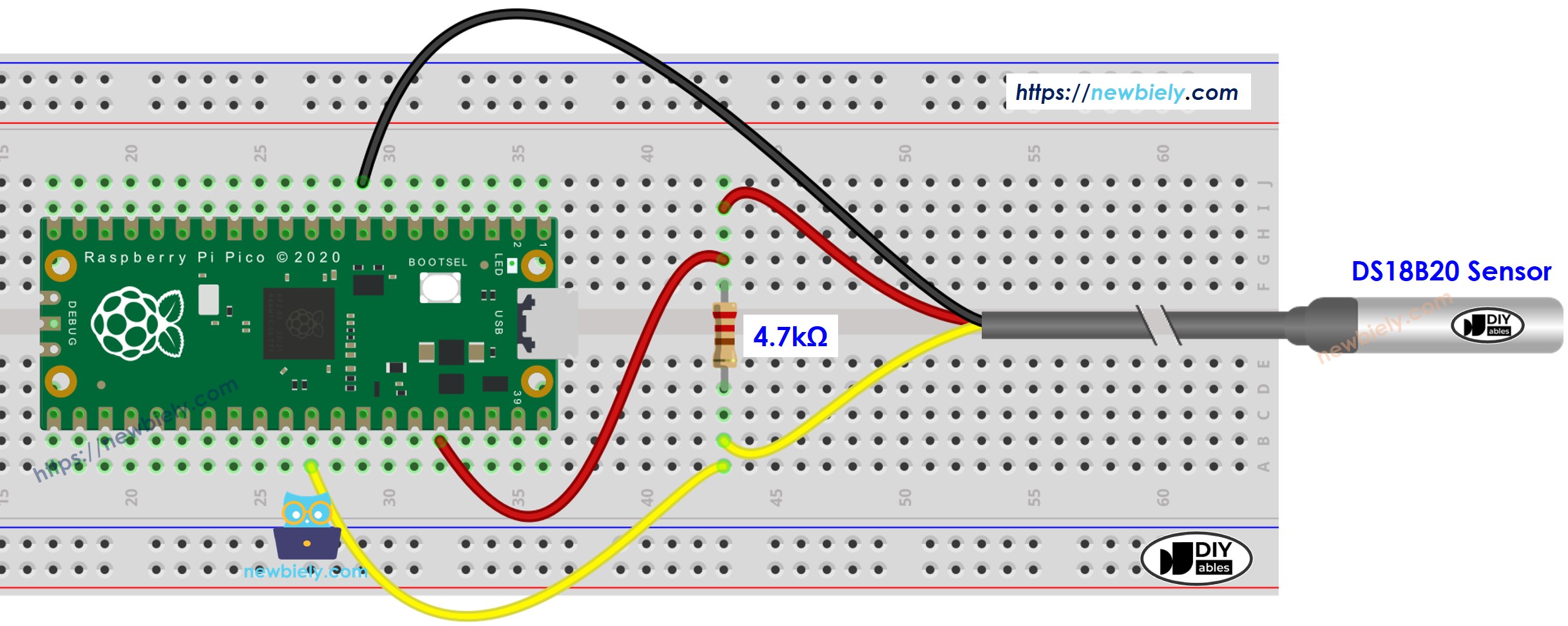Raspberry Pi Pico - Temperature Sensor
This guide shows you how to use the DS18B20 1-wire temperature sensor with the Raspberry Pi Pico. We will cover:
- How to connect the DS18B20 temperature sensor to a Raspberry Pi Pico.
- How to connect the DS18B20 temperature sensor to a Raspberry Pi Pico using an adapter.
- How to write a program for the Raspberry Pi Pico to get the temperature reading from the DS18B20 sensor.

Hardware Preparation
Or you can buy the following kits:
| 1 | × | DIYables Sensor Kit (30 sensors/displays) | |
| 1 | × | DIYables Sensor Kit (18 sensors/displays) |
Additionally, some of these links are for products from our own brand, DIYables .
Buy Note: Many DS18B20 sensors available in the market are unreliable. We strongly recommend buying the sensor from the DIYables brand using the link provided above. We tested it, and it worked reliably.
Overview of One Wire Temperature Sensor DS18B20
Pinout
The DS18B20 temperature sensor has three pins.
- GND pin: Attach it to GND (0 volts).
- VCC pin: Attach it to VCC (either 5 volts or 3.3 volts).
- DATA pin: This is used for 1-Wire Data. Connect it to a digital pin on the Raspberry Pi Pico.
There are two kinds of sensors: the TO-92 package, which resembles a transistor, and the waterproof probe. In this guide, we will use the waterproof probe.

To connect a DS18B20 temperature sensor to a Raspberry Pi Pico, you need a pull-up resistor. This can be complex. However, some manufacturers offer a wiring adapter that includes a pull-up resistor and a screw terminal block, making the setup easier.
Wiring Diagram
- Diagram of Breadboard Connections

This image is created using Fritzing. Click to enlarge image
- Wiring diagram and adapter instructions

This image is created using Fritzing. Click to enlarge image
We suggest getting a DS18B20 sensor with a wiring adapter. This adapter helps you easily connect the sensor as it already has a resistor included, so you do not need another one.
Raspberry Pi Pico Code
Detailed Instructions
Please follow these instructions step by step:
- Ensure that Thonny IDE is installed on your computer.
- Ensure that MicroPython firmware is installed on your Raspberry Pi Pico.
- If this is your first time using a Raspberry Pico, refer to the Raspberry Pi Pico - Getting Started tutorial for detailed instructions.
- Follow the given diagram to attach the DS18B20 1-wire temperature sensor to the Raspberry Pi Pico.
- Connect the Raspberry Pi Pico to your computer using a USB cable.
- Launch the Thonny IDE on your computer.
- On Thonny IDE, select MicroPython (Raspberry Pi Pico) Interpreter by navigating to Tools Options.
- In the Interpreter tab, select MicroPython (Raspberry Pi Pico) from the drop-down menu.
- Ensure the correct port is selected. Thonny IDE should automatically detect the port, but you may need to select it manually (e.g., COM3 on Windows or /dev/ttyACM0 on Linux).
- Copy the above code and paste it to the Thonny IDE's editor.
- Save the script to your Raspberry Pi Pico by:
- Click the Save button, or use Ctrl+S keys.
- In the save dialog, you will see two sections: This computer and Raspberry Pi Pico. Select Raspberry Pi Pico
- Save the file as main.py
- Click the green Run button (or press F5) to run the script. The script will execute.
- Put the sensor in hot and cold water, or hold it in your hand.
- Check out the message in the Shell at the bottom of Thonny.
If you name your script main.py and save it to the root directory of the Raspberry Pi Pico, it will automatically run each time the Pico is powered on or reset. This is useful for standalone applications that need to start running immediately upon power-up. If you name your script another name other than main.py, you will need to manually run it from Thonnys's Shell.
